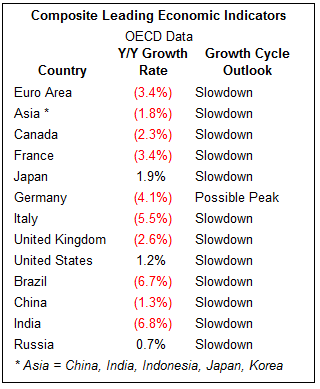IDEX Online Research: Economic Outlook Remains Murky
March 28, 12
(IDEX Online News) – Composite leading indicators point to a slowdown in economic activity in most of the diamond and jewelry consuming countries around the world, according to the latest data from the OECD.
The OECD tracks leading economic indicators for both its member countries – the U.S., virtually all European countries (East and West Europe), and Asian countries – as well major non-member economies including China, India, and the Middle East Arabic countries.
In virtually all of those economies, a slowdown is forecasted, with some economies expected to be weaker than other countries.
The composite leading indicators in August, the latest data available, for the U.S., Germany and Russia point more strongly to a slowdown than in prior periods.
However, IDEX Online Research notes that the U.S. just reported preliminary economic growth of 2.5 percent for the third quarter, well ahead of expectations and above first quarter’s 0.9 percent growth and second quarter’s 1.3 percent growth. Thus, it is less likely that the U.S. will experience a double-dip recession near term.
The composite leading indicators for Japan indicate a potential negative turning point in economic activity, but there are no strong signs of a slowdown yet.
The table below summarizes trends for composite leading indicators for major countries around the world, their growth rate and the growth cycle outlook.
 Source: OECD |
Despite the prospects for an economic slowdown, there is one relatively stable spot: the unemployment rate among the OECD countries. While unemployment remains at or near historic highs in those countries, it seems to have peaked.
The OECD countries are the major diamond and jewelry consuming countries of the world; their composite unemployment rate remained stable at 8.2 percent for August, the latest data available.
The table below summarizes the unemployment rate for the second calendar quarter for OECD countries. There has been little change in the unemployment rate in either July or August for those countries. Second quarter unemployment trends are shown because they represent a broad period; further, many countries have yet to report their final August unemployment data.

Source: OECD